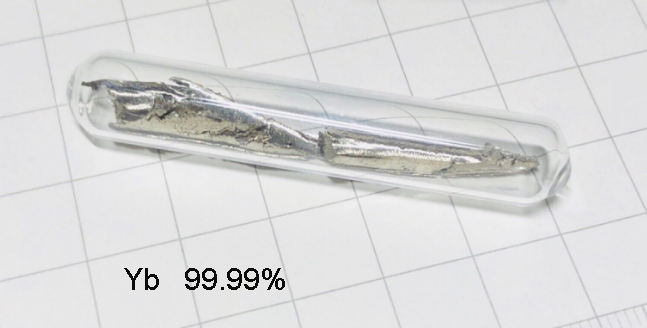Ytterbium metal
Ytterbium metal is silver-gray, malleable, soft, shiny, and easy
to oxidize. It is slowly corroded in the air and soluble in dilute acid
and liquid ammonia. It can act slowly with water. The divalent salt is
green, soluble in water, and reacts with water to slowly release
hydrogen; the trivalent salt is colorless. The oxide is white. A
malleable silver-white metal, rich in luster.
Ytterbium is a variable-valence rare earth, in addition to the positive
trivalent state, it can also be in a positive bivalent state. Due to
this variable price characteristic, the electrolysis method is not
suitable for preparing metal ytterbium, but the reduction distillation
method is used for preparation and purification. Generally, metallic
lanthanum is used as a reducing agent, and the difference between the
high vapor pressure of ytterbium metal and the low vapor pressure of
lanthanum metal is used for reductive distillation. It is also possible
to use thulium, ytterbium and lutetium enrichment as raw materials, use
metal lanthanum as a reducing agent, and directly extract metal
ytterbium by reduction-distillation under high-temperature vacuum
conditions of >1100°C and <0.133Pa. Like samarium and europium,
ytterbium can also be separated and purified by wet reduction. Usually
the thulium-ytterbium-lutetium-enriched material is used as a raw
material, and the ytterbium is reduced to a divalent state after
dissolution, and it is separated from other trivalent rare earths after
a significant difference in properties. The preparation of high-purity
ytterbium oxide usually uses extraction chromatography or ion exchange.
Application field
In the nuclear reaction, 169Tm is irradiated to generate 170Tm with a
half-life of 129 days. This isotope gram emits strong X-rays. It is
often used to produce Ytterbium oxide Yb2O3 by reducing it with calcium.
It can also be prepared by distillation (see Europium).
Used in the manufacture of special alloys. Used in metallurgy and
chemical experiments, ytterbium alloy has been used in dental medicine.
In recent years, Ytterbium has emerged and developed rapidly in the two
major fields of optical fiber communication and laser technology.
Ytterbium is also used as phosphor activator, radio ceramics, electronic
computer memory element (magnetic bubble) additives and optical glass
additives.
.
.

Ytterbium metal is silver-gray, malleable, soft, shiny, and easy
to oxidize. It is slowly corroded in the air and soluble in dilute acid
and liquid ammonia. It can act slowly with water. The divalent salt is
green, soluble in water, and reacts with water to slowly release
hydrogen; the trivalent salt is colorless. The oxide is white. A
malleable silver-white metal, rich in luster.
Ytterbium is a variable-valence rare earth, in addition to the positive
trivalent state, it can also be in a positive bivalent state. Due to
this variable price characteristic, the electrolysis method is not
suitable for preparing metal ytterbium, but the reduction distillation
method is used for preparation and purification. Generally, metallic
lanthanum is used as a reducing agent, and the difference between the
high vapor pressure of ytterbium metal and the low vapor pressure of
lanthanum metal is used for reductive distillation. It is also possible
to use thulium, ytterbium and lutetium enrichment as raw materials, use
metal lanthanum as a reducing agent, and directly extract metal
ytterbium by reduction-distillation under high-temperature vacuum
conditions of >1100°C and <0.133Pa. Like samarium and europium,
ytterbium can also be separated and purified by wet reduction. Usually
the thulium-ytterbium-lutetium-enriched material is used as a raw
material, and the ytterbium is reduced to a divalent state after
dissolution, and it is separated from other trivalent rare earths after
a significant difference in properties. The preparation of high-purity
ytterbium oxide usually uses extraction chromatography or ion exchange.
Application field
In the nuclear reaction, 169Tm is irradiated to generate 170Tm with a
half-life of 129 days. This isotope gram emits strong X-rays. It is
often used to produce Ytterbium oxide Yb2O3 by reducing it with calcium.
It can also be prepared by distillation (see Europium).
Used in the manufacture of special alloys. Used in metallurgy and
chemical experiments, ytterbium alloy has been used in dental medicine.
In recent years, Ytterbium has emerged and developed rapidly in the two
major fields of optical fiber communication and laser technology.
Ytterbium is also used as phosphor activator, radio ceramics, electronic
computer memory element (magnetic bubble) additives and optical glass
additives.
.
.

|
|
